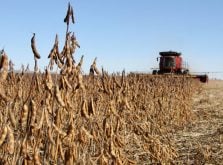A new study says pulse processors could pass on considerable transportation savings to farmers if they doubled the number of containers they load onto semi-trailers at their plants.
About 60 percent of Canadian pulse production is exported. Twenty percent of those exports moved by inland containers in 1999 and their popularity is increasing.
Shippers like containers because the identity of edible pulses moved that way is preserved and they get to export position faster than product moving in bulk in hopper cars.
But a problem has arisen with container traffic. There are only two locations in Saskatchewan where the railways provide container service – Saskatoon and Regina.
Read Also

Manitoba extends Crown land rent freeze
Manitoba government links the continued rental rate freeze on grazing and forage leases to economic and environmental challenges facing the industry
Pulse processors located a long way from those two cities pay significant fees to have the containers delivered to them and transported back to the cities by truck.
“Pick-up and delivery fees if you’re 200 kilometres out can be getting close to $400 to move 20 tonnes,” said Paul Beingessner, the transportation consultant who wrote the report.
“That’s $20 a tonne. I mean you could almost move a tonne of wheat to Vancouver for that.”
Saskatchewan Pulse Growers commissioned Beingessner to figure out a way to reduce those hefty delivery costs. The answer he came up with is to load two containers onto the flat deck of a semi-trailer instead of just one.
For a processor located 200 kilometres from a container terminal, the cost savings over hauling two single containers would work out to $209.55 or $4.89 per tonne.
Beingessner figures a good portion of that savings would make its way back into farmers’ pockets. He said the pulse processing industry has become quite competitive. Processors are aggressive in soliciting business. They could use some or all of those transportation savings to attract business.
Beingessner’s proposal relies heavily on Saskatchewan Highways and Transportation partnership agreements, which allow truckers to exceed gross vehicle weight restrictions on provincial highways. The shipper and trucking company must pay an asphalt fee and share some of their savings with the government to mitigate the extra road damage that occurs.
The forestry industry has made good use of those agreements, but agriculture has not.
Some area transportation planning committees and rural municipalities don’t want to damage their secondary highways any further by exceeding weight limits. They are also worried that more truck movement could affect traffic levels on short-line railways in their regions, said Beingessner.
Even with the partnership agreements, which allow truckers to use primary highway weight restrictions on the secondary roads where most pulse processing facilities are located, weight is still going to be a concern.
Beingessner estimates that a conventional b-train carrying two containers loaded with pulses would weigh around 64,000 kilograms, which exceeds the maximum allowable weight on primary highways by 1,500 kg.
But things can be done to reduce the weight of trucks, like using day caps on cabs rather than night sleepers. A truck manufacturer called Load King has already designed a b-train configured specifically for carrying two 20-foot containers while remaining within the 62,500 kg weight limit.
Trucking companies and shippers may also consider using central tire inflation devices, which further increases weight limits on secondary highways to as high as 70,500 kg in the summer and 72,500 kg in the winter.
With a little ingenuity, pulse processors can start implementing cost-saving measures for shipping containers immediately and begin passing those savings on to farmers right away, said Beingessner.
“Really there isn’t a whole lot of changes that need to be done.”















